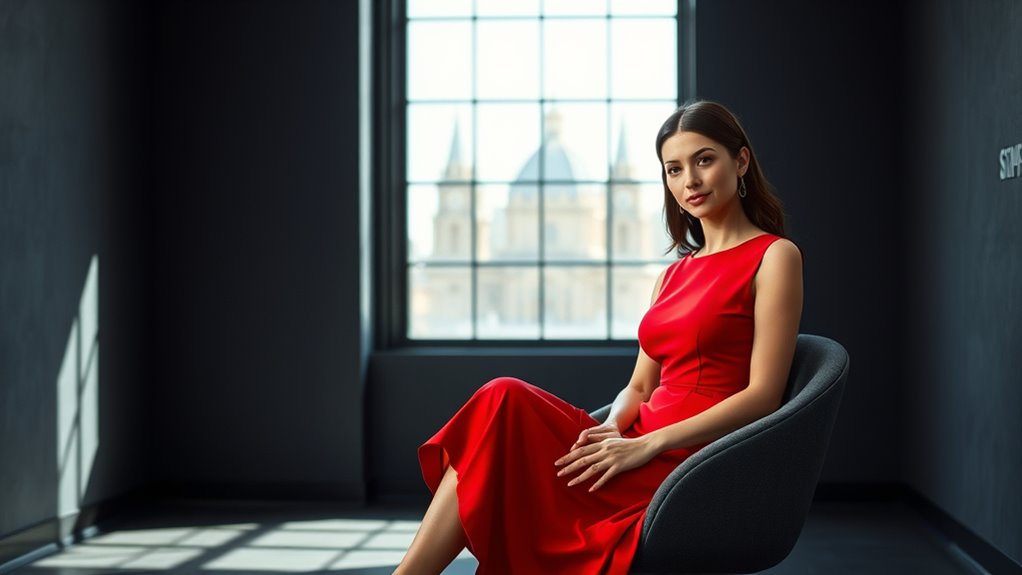Your clothing choices hold hidden power to shape perceptions and influence emotions in any room. Wearing bold colors like red or black can boost your confidence and project authority, while softer shades like pastels make you appear approachable and friendly. Choosing colors intentionally allows you to craft the impression you desire, whether it’s trust, respect, or creativity. Keep exploring, and you’ll discover how every hue can be a strategic tool to command attention and leave a lasting impact.
Key Takeaways
- Choose bold colors like red or royal purple to convey confidence and authority in professional or social settings.
- Use softer hues or pastels to appear approachable and foster easier connections with others.
- Align your clothing colors with your desired message—black for power, vibrant tones for creativity, earth tones for trustworthiness.
- Understand that color influences perceptions subconsciously, shaping how others see your personality and intentions.
- Dress intentionally with color to amplify your emotional state and project the impression you want to leave in any room.

Understanding the psychology of color reveals how different hues influence your emotions, perceptions, and behaviors. When you choose your outfit, you’re not just selecting a piece of clothing; you’re sending a subtle message about how you want to be perceived. Color perception plays an essential role in shaping others’ impressions of you, often without you realizing it. For example, wearing red can signal confidence and passion, while blue might convey calmness and trustworthiness. Recognizing these nuances allows you to harness the emotional impact of colors to influence any room you enter. The colors you wear can evoke specific feelings in others—whether it’s respect, friendliness, or authority—and understanding this gives you a strategic advantage when dressing for success or social interactions.
Your choice of color influences more than just how others see you; it also affects how you feel internally. If you want to boost your confidence before a big meeting, donning a bold hue like crimson or royal purple can elevate your mood and help you project strength. Conversely, softer shades like pastels can create a sense of approachability and ease, making interactions smoother. The emotional impact of color isn’t just about the immediate impression; it can alter your own mindset, reinforcing the persona you want to embody. When you select clothing with intent, you’re actively shaping your emotional state and the environment around you.
Thinking about divorce process steps and their implications can help you better prepare for the emotional journey ahead. Think about the context—what message do you want to send? If you’re aiming for authority or leadership, black or dark gray can give you a commanding presence. For a more creative or approachable vibe, earthy tones or vibrant colors might serve you better. The key is understanding how these colors influence perceptions and emotions simultaneously. When you dress intentionally, you leverage the power of color perception to craft an image that aligns with your goals. It’s not just about aesthetics but about creating a psychological impact that resonates with others and bolsters your confidence.
In essence, your wardrobe becomes a tool for psychological influence. By understanding how different colors evoke specific emotional responses and perceptions, you can dress to command attention, foster trust, or convey professionalism. The right color choice amplifies your message without saying a word. So next time you get dressed, consider the emotional impact of the hues you select—you’re not just choosing clothes; you’re shaping how the world perceives and reacts to you.
Frequently Asked Questions
How Does Color Choice Affect First Impressions?
Your color choice shapes first impressions considerably. Different colors carry symbolism and evoke emotional responses, influencing how others perceive you. For instance, red can signal confidence and passion, while blue often suggests trustworthiness and calmness. By understanding color symbolism, you can select hues that align with your desired impression, making your appearance more impactful and memorable. Choose wisely to communicate your message effortlessly through color.
Can Clothing Color Influence Workplace Dynamics?
Imagine you’re in a medieval court, where color choice signals status. In the workplace, your clothing color influences dynamics through color consistency and dress code norms. Wearing confident hues like blue or gray fosters trust and professionalism, while bold colors can project creativity. By aligning your wardrobe with these norms, you shape perceptions, boost authority, and influence interactions—making your clothing choices a silent yet powerful tool in workplace relationships.
Are Certain Colors More Effective for Leadership Presence?
Certain colors can boost your leadership presence by leveraging color symbolism and psychological associations. For example, navy and dark gray convey professionalism and authority, while red signals confidence and assertiveness. Wearing these colors helps you project strength and influence, making your leadership qualities more apparent. Choose your attire thoughtfully, as specific colors can reinforce your message and positively impact how others perceive your leadership role.
How Do Personal Color Preferences Impact Perception?
Think of personal color preferences like a unique melody in a symphony; they shape how others perceive you. Your favorite shades create color harmony and evoke emotional associations, influencing perceptions of confidence or approachability. For example, wearing a color you love can boost your authenticity, making you seem more trustworthy. Ultimately, embracing your preferences helps you communicate your true self and positively impact how you’re perceived in any room.
Does Cultural Background Change Color Psychology?
Cultural background definitely influences your perception of color psychology. Different cultures assign unique cultural symbolism and color associations, shaping how you interpret colors. For example, white may symbolize purity in some cultures but mourning in others. These cultural nuances affect your emotional reactions and choices, so understanding them helps you better grasp how color influences behavior across diverse cultural contexts.
Conclusion
Think of yourself as a painter, choosing colors for a blank canvas—you hold the brush to influence how others see and feel in any room. By understanding the psychology of color, you become the artist of your environment, crafting moods and impressions with each hue. When you dress intentionally, you’re not just wearing clothes—you’re painting a picture of confidence, calm, or energy. Master this palette, and you’ll command any space with the power of color.









